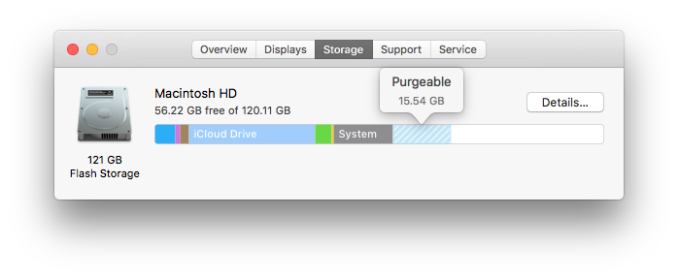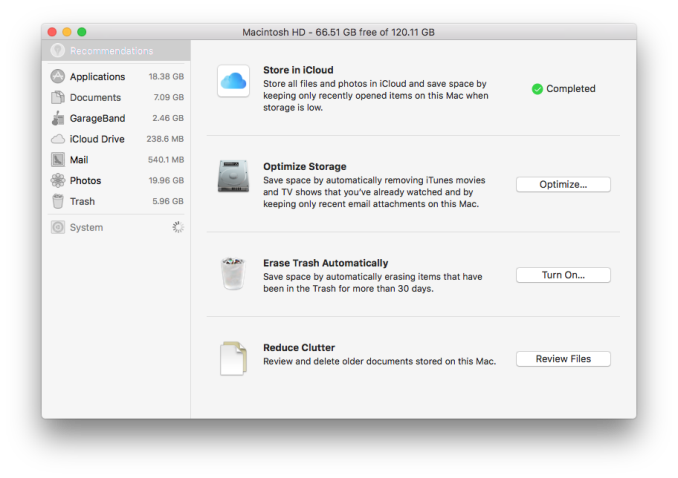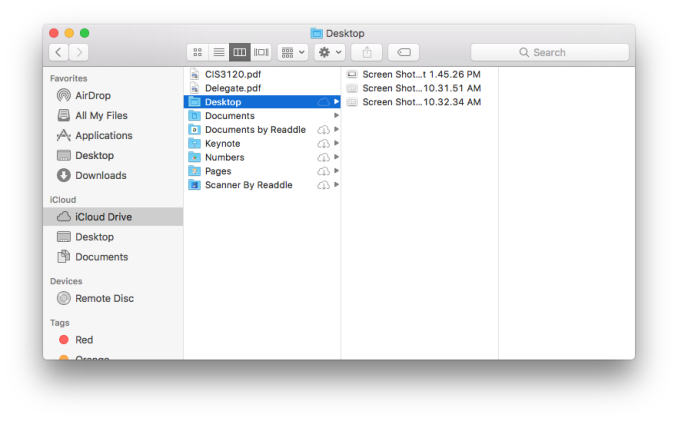A First Look At Apple's macOS Sierra
by Brandon Chester on July 13, 2016 8:00 AM EST- Posted in
- Mac
- Apple
- Operating Systems
- macOS
Storage Optimization
I don't think anyone would say that the move to SSDs in laptops was a step backward, but the transition meant computers that once included a 500GB or 1TB hard drive in the base model now come with a 128GB or perhaps a 256GB SSD. Meanwhile, the amount of data that users keep has continually increased as they take more photos, record more videos, and listen to more music. Streaming content has alleviated storage pressure to some extent, but in the end you simply have less local storage to work with nowadays than in the past.
macOS Sierra brings some new features to help users reduce storage pressure. Some of this has to do with leveraging the cloud for file storage, while other parts are designed to help with cleaning up things on a Mac that can be removed. It's no secret that computers running Windows and macOS both end up accumulating files that the user doesn't want and often doesn't even know exist. Unfortunately, it has never been easy to track all of these files down, which opened up a market for computer cleaner software that is sometimes less than reputable. In macOS Sierra there's now a central area for tracking what is taking up a lot of space on your Mac, along with controls and recommendations on how to free up space.
When you open the new storage management panel in Sierra you'll first see the screen that shows recommendations. Most of these are fairly standard, such as setting the trash to automatically empty itself, removing old mail attachments and iTunes movies, and using optimized photos instead of storing the original full resolution images on your device. There's also an option to reduce clutter by removing old documents stored on the Mac, which opens up a screen that additionally shows you some of the largest files on your Mac, which can be a great way to clear out the largest files that you don't need anymore. In fact, on my test device this feature found several temporary files related to the beta that were over a gigabyte in size each, and I definitely wouldn't have found them by just looking through Finder.
Among all the options to help reduce storage pressure, there's one that stands out. The new Store in iCloud feature claims to store all files and photos in iCloud and keeps only recently utilized files on your local drive. I'm not sure if "all files" is a bit of an exaggeration, but the list of things that it will move to the cloud is quite comprehensive, and it includes files like unused fonts, language packs, unused Mac App Store apps, and many other things that you would never have time to clean off your computer even if you never use them. Most important of all is that this does not count against your iCloud storage. The justification for this is likely that many of these things are actually parts of macOS that can be downloaded on demand, and even in the case of your own files it's not as if they're being synced across your devices so it's not using iCloud in the same way that file syncing does. This means that users who have kept the standard 5GB storage allotment don't need to worry about all the files from their computer suddenly filling up their iCloud Drive.
As someone who uses a 256GB iMac for iOS development, the new Store in iCloud feature in macOS Sierra interests me greatly. Even though I keep my media stored on a NAS, there are still times where there's storage pressure just due to files I'm currently working on and media that I've downloaded locally without having moved it to the NAS yet. At WWDC Apple stated that turning on all the storage optimization options in Sierra brought a 250GB Mac with 20GB free to 150GB free. While I doubt this is typical, and it certainly wasn't just due to moving data to iCloud, even a few extra gigabytes here and there would go a long way to help Mac users with smaller SSDs.
iCloud Desktop and Documents
A feature separate from optimized storage is iCloud Desktop and Documents. This feature does utilize your iCloud storage, but it also provides a very useful way of syncing files across all your macOS and iOS devices. With this feature enabled all files and folders that are within the Desktop and Documents folders on your Macs will be synced across iCloud. This means that every Mac you use will have the same desktop, and all of your documents. On iOS these can be accessed via the iCloud Drive app, and assuming the format is something that can be handled by a system-level or third-party iOS app you'll be able to open it there as well.
One apparent oversight with iCloud desktop and document syncing is the ability to have a limit on the size of files that will sync. For example, I don't want large video files on my laptop that end up in documents or on the desktop to then be uploaded to iCloud and downloaded to my other Macs. My desktop computers don't store media locally at all because it's all streamed from a NAS, and the laptop only has local media content so it can be accessible when I'm not at home. It would be helpful if Apple provided mechanisms to exclude certain files or folders within the desktop and documents folders from iCloud syncing, as well as some setting that stopped files above a certain size from syncing to iCloud unless you explicitly tell it to.
I'm sure someone within Apple is already aware that this feature needs some configurable options, and by the time macOS Sierra releases later this year I'm sure there will be a solution in place. Beyond that there's not a whole lot else to say about the feature. I've been in a number of situations where I wished I could get at a file on the desktop of my home computer from my work computer, but without SSH or VNC set up there was no way to do so. Having things sync to the cloud on their own means that's never something you have to worry about again, and sometimes the best features are the ones that just give you a bit of peace of mind.













81 Comments
View All Comments
WaitingForNehalem - Wednesday, July 13, 2016 - link
It would have been nice to cover improvements to the kernel and the new file system...you know the important parts of an operating system.Brandon Chester - Wednesday, July 13, 2016 - link
APFS isnt even shipping until 2017, it's not a Sierra feature.damianrobertjones - Wednesday, July 13, 2016 - link
Whatever you do Apple... DO NOT give this update away for free as the entire internet, or a selection of loud mouthed people, will slam it and refuse to update. /s (Windows 10 anyone?)theduckofdeath - Thursday, July 14, 2016 - link
Yup, with a rate outpacing the previous fastest ever adopted operating system-release by around 145% is a massive failure, amirite?!...I know a small but loud group wanted to create the impression that no one updated to Windows 10, but that attempt failed miserably, like most internet trolling attempts tends to do.
Ascaris - Sunday, July 17, 2016 - link
145% for one month, when no other version of Windows has been a free upgrade before, so all of the early adopters that might have had to wait to afford it don't have to wait-- yeah, that's quite an accomplishment. What about the heaps of people who resent MS for what they've done, and are more likely than ever before to jump ship to Apple or Linux? I remember the browser wars, the introduction of WGA, Windows Vista, Windows 8... but I don't remember there ever being this level of contempt for MS and the product in question than there is now. Is alienating all of their customers part of some kind of grand plan? If I were a MS competitor secretly plotting to destroy them, I don't think I would do anything different than MS has.But yeah, plenty of people upgraded to Windows 10-- though their target of a billion devices by ($date) won't happen, as they've admitted, but there have been a bunch. Many of them are people who were not tech-savvy enough to know how to block 10, and they're not happy about it. So much for people using Windows because they want to and not because they have to!
There's a difference between giving something away and essentially forcing people to take it even as they tell you they don't want it. I've never liked Apple, but they've never stooped to using malware techniques and dark pattern trickery to get people to upgrade to something free. They stick to that old-fashioned method of trying to produce products people want so that they'll buy them. Microsoft has a different idea-- make something no one wants, then force them to upgrade with dirty tricks.
Oh, and the growth rate of Linux last month (as reported by Netmarketshare.com) was 30% higher than that of Windows 10. Another Microsoft achievement!
Commodus - Tuesday, July 19, 2016 - link
You're being a bit hyperbolic. It's not that no one wanted to upgrade to Windows 10, it's that there's a significant minority that doesn't... and isn't happy that Microsoft used underhanded tactics to upgrade some people without their explicit consent.There are very real stories of people who didn't realize that Windows was set to auto-upgrade and came back to see their PC running Windows 10. I'm sorry, but that's just not cool -- even Apple with its relatively aggressive upgrade strategy won't automatically install the latest version of macOS.
It's a classic example of letting business goals override what the user wants.
ex2bot - Friday, July 15, 2016 - link
Mac OS updates have been free for years now. And there is a vocal minority who refuses to update past 10.6.Hyper72 - Monday, July 18, 2016 - link
Not that it have much relevance; but the app store always suggests me to install latest free version of OS X. It's too bad it immediately fails as my 2006 MacBook Pro C2D doesn't run anything more recent than Lion. That means I can't run latest X Code, so only way I can try out Swift is in a Linux VM which doesn't target iOS or macOS - sigh.Meteor2 - Wednesday, July 27, 2016 - link
It might be time to replace your ten year old computer.wsjudd - Wednesday, July 13, 2016 - link
For anyone curious what the YouTube link spotted in the Messages screenshot was: https://www.youtube.com/watch?v=ETfiUYij5UE